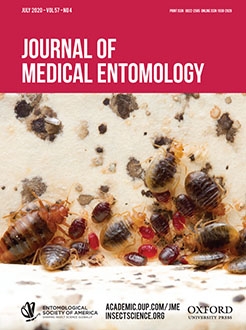Aedes aegypti (L.), the main vector of dengue and other arboviruses, was declared eradicated from Argentina in 1964; however, in 1987, it was detected again and nowadays it occurs in most of the country territory. To understand the transmission of vector-borne diseases, knowledge of the dispersal of vector populations is essential to evaluate the risk of pathogen transmission. We conducted a population genetic analysis of Ae. aegypti in 20 neighborhoods from Córdoba, the second largest city in Argentina, using 10 microsatellite loci. High genetic differentiation and the absence of an isolation by distance pattern was found using Weir and Cockerham's θ. Bayesian and multivariate clustering analyses showed that the studied sites included individuals with high membership coefficients (Q) in their populations, individuals with membership in another cluster, and admixed individuals. Individuals with high Q in clusters different from the population in which they were collected strongly suggests that passive transport is important in shaping the Ae. aegypti dispersal pattern in Córdoba city. Knowing the genetic structure of Ae. aegypti populations and their dispersal patterns would contribute to the implementation of vector control programs.
How to translate text using browser tools
13 February 2020
Urban Populations of Aedes aegypti (Diptera: Culicidae) From Central Argentina: Dispersal Patterns Assessed by Bayesian and Multivariate Methods
Ana María Ayala,
Noelia Soledad Vera,
Marina Beatriz Chiappero,
Walter Ricardo Almirón,
Cristina Noemí Gardenal
ACCESS THE FULL ARTICLE
It is not available for individual sale.
This article is only available to subscribers.
It is not available for individual sale.
It is not available for individual sale.

Journal of Medical Entomology
Vol. 57 • No. 4
July 2020
Vol. 57 • No. 4
July 2020
Aedes aegypti
Córdoba city (Argentina)
microsatellites
population genetic structure




